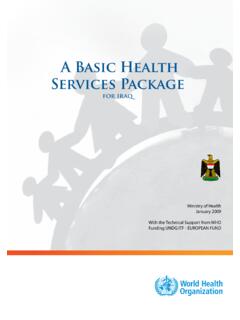Transcription of Cerebrospinal Fluid Analysis - AAFP Home
1 SEPTEMBER15, 2003 / VOLUME68, , and cautioned not to hyperventilate,because hyperventilating will lower the open-ing opening pressure ranges from 10 to100 mm H20 in young children, 60 to 200 mmH20 after eight years of age, and up to 250 mmH20 in obese hypoten-sion is defined as an opening pressure of lessthan 60 mm H20. This finding is rare except inpatients with a history of trauma causing aCSF leak, or whenever the patient has had aprevious lumbar pressures above 250 mm H20 arediagnostic of intracranial hypertension. Ele-vated intracranial pressure is present in manypathologic states, including meningitis,intracranial hemorrhage, and tumors.
2 Idio-pathic intracranial hypertension is a conditionmost commonly seen in obese women duringtheir childbearing years. When an elevatedopening pressure is discovered, CSF should beremoved slowly and the pressure monitoredduring the procedure. No additional CSFshould be removed once the pressure reaches50 percent of the opening care physicians frequentlyperform lumbar puncture, be-cause Cerebrospinal Fluid (CSF) isan invaluable diagnostic windowto the central nervous system(CNS). Commonly performed tests on CSFinclude protein and glucose levels, cell countsand differential, microscopic examination,and culture. Additional tests such as openingpressure, supernatant color, latex agglutina-tion, and polymerase chain reaction also maybe performed.
3 Knowing which tests to orderand how to interpret them allows physiciansto use CSF as a key diagnostic tool in a vari-ety of PressureTo measure CSF opening pressure, thepatient must be in the lateral decubitus posi-tion with the legs and neck in a neutral posi-tion. The meniscus will fluctuate between 2and 5 mm with the patient s pulse andbetween 4 and 10 mm with should be advised not to strain,because straining can increase the openingLumbar puncture is frequently performed in primary care. Properly interpreted tests canmake Cerebrospinal Fluid (CSF) a key tool in the diagnosis of a variety of diseases. Proper eval-uation of CSF depends on knowing which tests to order, normal ranges for the patient s age,and the test s limitations.
4 Protein level, opening pressure, and CSF-to-serum glucose ratiovary with age. Xanthochromia is most often caused by the presence of blood, but severalother conditions should be considered. The presence of blood can be a reliable predictor ofsubarachnoid hemorrhage but takes several hours to develop. The three-tube method, com-monly used to rule out a central nervous system hemorrhage after a traumatic tap, is notcompletely reliable. Red blood cells in CSF caused by a traumatic tap or a subarachnoid hem-orrhage artificially increase the white blood cell count and protein level, thereby confound-ing the diagnosis. Diagnostic uncertainty can be decreased by using accepted corrective for-mulas.
5 White blood cell differential may be misleading early in the course of meningitis,because more than 10 percent of cases with bacterial infection will have an initial lympho-cytic predominance and viral meningitis may initially be dominated by neutrophils. Culture isthe gold standard for determining the causative organism in meningitis. However, poly-merase chain reaction is much faster and more sensitive in some circumstances. Latex agglu-tination, with high sensitivity but low specificity, may have a role in managing partiallytreated meningitis. To prove herpetic, cryptococcal, or tubercular infection, special stainingtechniques or collection methods may be required.
6 (Am Fam Physician 2003;68:1103-8. Copy-right 2003 American Academy of Family Physicians.) Cerebrospinal Fluid AnalysisDEAN A. SEEHUSEN, , MARK M. REEVES, , and DEMITRI A. FOMIN, Army Medical Center, Honolulu, HawaiiSee page 1039 fordefinitions of strength-of-evidence ColorNormal CSF is crystal clear. However, as fewas 200 white blood cells (WBCs) per mm3or400 red blood cells (RBCs) per mm3will causeCSF to appear turbid. Xanthochromia is a yel-low, orange, or pink discoloration of the CSF,most often caused by the lysis of RBCs result-ing in hemoglobin breakdown to oxyhemo-globin, methemoglobin, and bilirubin. Discol-oration begins after RBCs have been in spinalfluid for about two hours, and remains for twoto four is present inmore than 90 percent of patients within 12 hours of subarachnoid hemorrhage onset2and in patients with serum bilirubin levelsbetween 10 to 15 mg per dL (171 to mol per L).
7 CSF protein levels of at least 150mg per dL ( g per L) as seen in manyinfectious and inflammatory conditions, or asa result of a traumatic tap that contains morethan 100,000 RBCs per mm3 also will resultin CSF is oftenxanthochromic because of the frequent eleva-tion of bilirubin and protein levels in this b l e 1lists CSF colors associated withvarious CountNormal CSF may contain up to 5 WBCs permm3in adults and 20 WBCs per mm3in percent of patients withbacterial meningitis will have a WBC counthigher than 1,000 per mm,3while 99 percentwill have more than 100 per lessthan 100 WBCs per mm3is more common inpatients with viral WBC counts also may occur after aseizure,7in intracerebral hemorrhage.
8 Withmalignancy, and in a variety of b l e 2lists common CSF findingsin various types of blood in the CSF after a trau-matic tap will result in an artificial increasein WBCs by one WBC for every 500 to 1,000 RBCs in the CSF. This correction factoris accurate as long as the peripheral WBCcount is not extremely high or traumatic tap occurs in approximately 20 percent of lumbar punctures. Commonpractice is to measure cell counts in threeconsecutive tubes of CSF. If the number ofRBCs is relatively constant, then it is assumedthat the blood is caused by an , NUMBER6 / SEPTEMBER15, 2003 TABLE 1 Cerebrospinal Fluid Supernatant Colorsand Associated Conditions or CausesColor of CSFsupernatant Conditions or causesYellowBlood breakdown products HyperbilirubinemiaCSF protein 150 mg per dL ( g per L) >100,000 red blood cells per mm3 OrangeBlood breakdown productsHigh carotenoid ingestionPinkBlood breakdown productsGreenHyperbilirubinemiaPurulent CSFB rownMeningeal melanomatosisCSF = Cerebrospinal from references 2, 4, and AuthorsDEAN A.
9 SEEHUSEN, , is a faculty development fellow in the Department of Fam-ily Practice at Madigan Army Medical Center, Tacoma, Wash. He formerly was a staffphysician in the Department of Family Practice and Emergency Medical Services atTripler Army Medical Center, Honolulu. He earned his medical degree from the Uni-versity of Iowa College of Medicine, Iowa City, and completed a residency in familypractice at Tripler Army Medical M. REEVES, , is director of the family practice residency program at TriplerArmy Medical Center. He earned his medical degree from the Uniformed Services Uni-versity of the health Sciences, Bethesda, Md., and completed a residency in familypractice at Dwight D.
10 Eisenhower Army Medical Center, Augusta, A. FOMIN, , is a staff neurologist in the Department of Medicine, neu-rology service, at Tripler Army Medical Center. He earned his medical degree from theUniformed Services University of the health Sciences and completed a residency inneurology at Walter Reed Army Medical Center, Washington, correspondence to Dean A. Seehusen, , 5803 152nd Ave. Ct. E, Sumner,WA 98390 (e-mail: Reprints are not available from the authors. Xanthochromia is present in more than 90 percent ofpatients within 12 hours of subarachnoid hemorrhage onset. hemorrhage. A falling count is attributed to atraumatic tap. The three-tube method, how-ever, is not always is a more reliable predictorof hemorrhage.)












